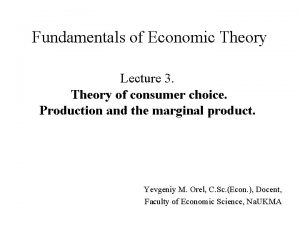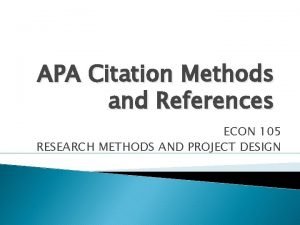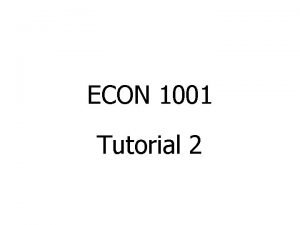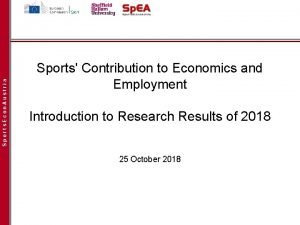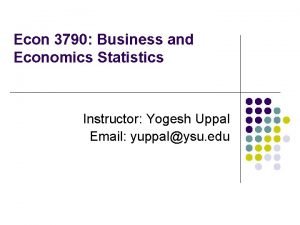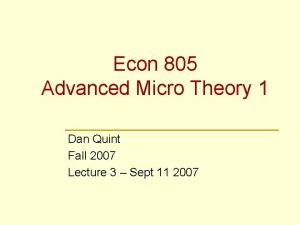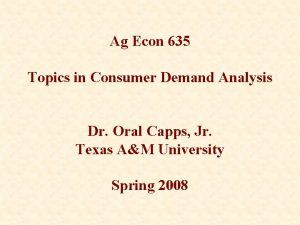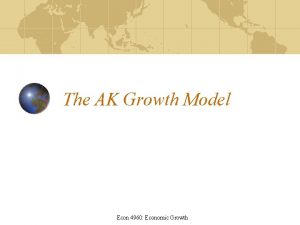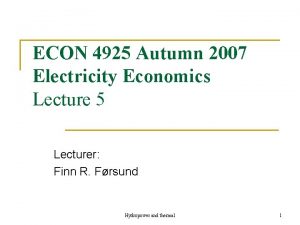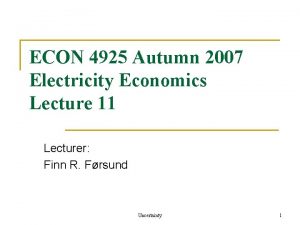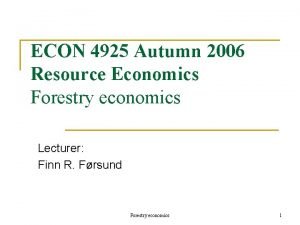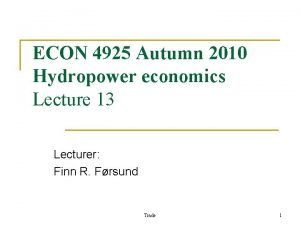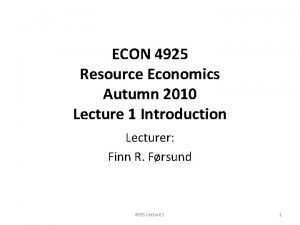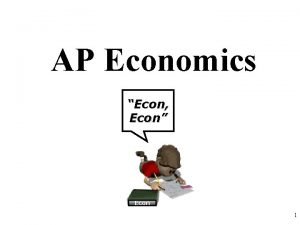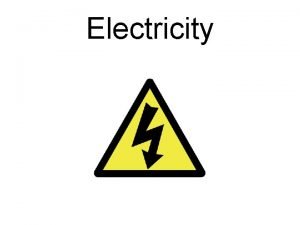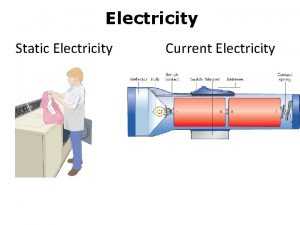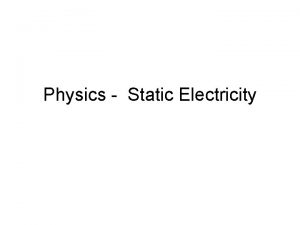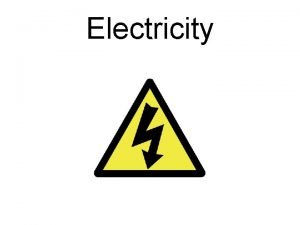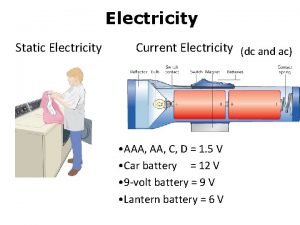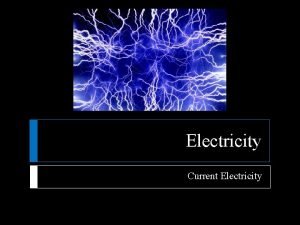ECON 4925 Autumn 2007 Electricity Economics Lecture 4





















- Slides: 21

ECON 4925 Autumn 2007 Electricity Economics Lecture 4 Lecturer: Finn R. Førsund Constraints 1

Modelling a production constraint Constraints 2

The Lagrangian Constraints 3

The Kuhn – Tucker conditions Constraints 4

Impact of a production constraint n A binding production constraint implies that the water value will in general be less than the social price q n The condition holds with equality since production is positive A binding constraint means less use of water compared with no constraint and therefore the price will be higher Constraints 5

A bathtub illustration: constraint in period 2: peak demand p 1 Period 1 p 2 Period 2 p 2=λ 2+ρ2 ρ2 λ 2 p 1=λ 1 A B B’ B’’ Constraints C D 6

A bathtub illustration: constraint in period 1: threat of overflow p 1 Period 1 p 2 Period 2 p 2=λ 2=γ 1 p 1=ρ1 γ 1 ρ1 λ 1=0 A B' B C D Spill Constraints 7

Must take: Run-of-the-river and wind power Period 2 Period 1 p 2(x 2) p 1(x 1) λ 1 λ 2 p 1 River flow e 1 R A e 1 H B M C e 2 H D e 2 R Total controllable inflow Constraints 8

Degree of filling Constraints 9

Solving for quantities, model with reservoir constraint only n Terminal period, two periods n The next period (first) going backwards q No threat of overflow Constraints 10

Solving for quantities, cont. n n n If we can determine , then we can solve for production quantities Using the water accumulation equation for period 1 One equation in one unknown, must know inflows and demand functions for both periods Constraints 11

Multiple plants n n N plants with reservoirs, a single aggregate consumer, xt = total consumption The energy balance has to hold as an equality Reservoir constraints only Constraints 12

The social planning problem Constraints 13

The Lagrangian function n Eliminating consumption by inserting the energy balance Constraints 14

The Kuhn – Tucker conditions Constraints 15

Backwards induction n The terminal period: No satiation of demand → all plants use up all water in the terminal period n If all reservoirs are in between full and empty in period T -1: the plants will face the same price equal to the water value in the terminal period also in period T -1 Constraints 16

Indeterminacy of plant quantities pt pt(xt) pt Total consumption xt o A Constraints 17

Equality of water values n n For a water value to change either the reservoir constraint must be binding or the reservoir is emptied Assume that the social price for periods t and t +1 are equal. Can it then be optimal for a plant to have a full reservoir in period t? q q Yes it may be optimal, but the shadow price on the reservoir constraint will be zero The reservoir must be full when the social price increases Constraints 18

Equality of water values, cont. n Assume that the social price is the same in period t and t +1. Can it then be optimal for a plant to empty the reservoir in period t ? q q q Yes, but the water value in period t and t +1 must be the same The reservoir must be full when the social price increases The reservoir must be emptied when the social price decreases Constraints 19

The case of pure accumulation n If the water value is greater than the social price, then production is zero and all inflows are accumulated A plant may accumulate water and produce zero for many periods The water value will be equal for all zero production periods and equal to the social price in the first period with positive production Constraints 20

Hveding’s conjecture n n Assume independent hydropower plants with one limited reservoir each, and perfect manoeuvrability of reservoirs, but plantspecific inflows The plants can be regarded as a single aggregate plant and the reservoirs can be regarded as a single aggregate reservoir when finding the social optimal solution for operating the hydropower system. Constraints 21
 Magnetism vocabulary
Magnetism vocabulary Static electricity and current electricity
Static electricity and current electricity Electricity n
Electricity n Electricity and magnetism lecture notes
Electricity and magnetism lecture notes 01:640:244 lecture notes - lecture 15: plat, idah, farad
01:640:244 lecture notes - lecture 15: plat, idah, farad Principles of economics powerpoint lecture slides
Principles of economics powerpoint lecture slides Land use planning lecture notes
Land use planning lecture notes Health economics lecture notes
Health economics lecture notes Mathematical economics vs non mathematical economics
Mathematical economics vs non mathematical economics Maastricht university school of business and economics
Maastricht university school of business and economics Econ
Econ Econ 105
Econ 105 Flipitecon
Flipitecon Ivrents
Ivrents Econ
Econ Econ austria
Econ austria Econ
Econ Econ
Econ Roy's identity
Roy's identity Velocity formula econ
Velocity formula econ The ak model
The ak model Econ 151
Econ 151










